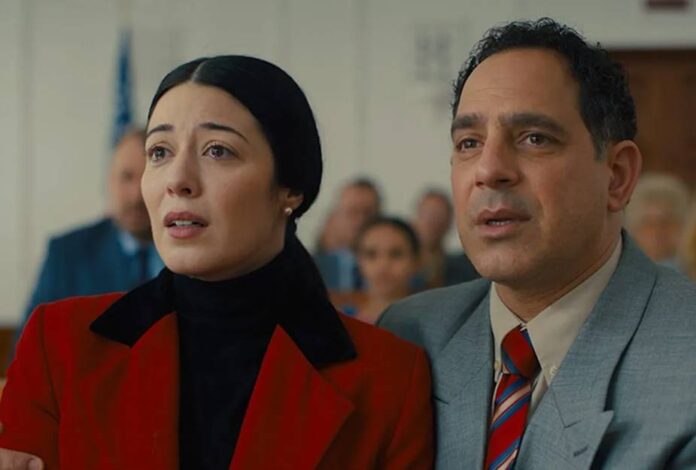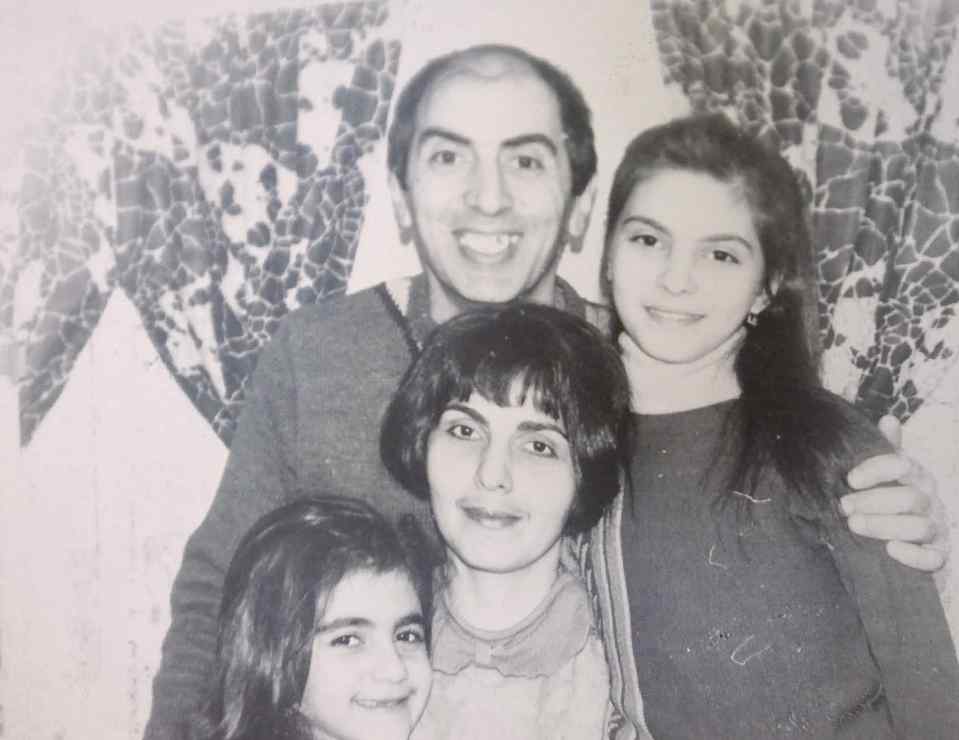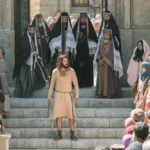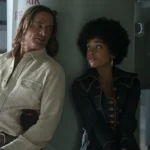Life is shaped by borders, but some stories go beyond them. These stories can happen in any time, any place, or any government. One of these stories is told in Between Borders (Original title: Beyond Borders), a historical drama released in 2024 to great reviews. This story is so strong, with so much pain and hope, that it will make you think about what it means to really be home. The simple Armenian family Petrosyan is caught in the chaos of the fall of the Soviet Union and has to leave their home country to find safety. But can they really get away from a world full of violence, racism, and discrimination?
Between Borders Movie Plot
In the late 1980s and early 1990s, as the Soviet Union starts to fall apart, the story takes place. In Between Borders, the story is about the journey of an Armenian couple named Ivan (Patrick Sabongui) and Violetta Petrosyan (Elizabeth Tabish) and their two daughters Olga (Natalia Badea) and Julia (Sofia Pistireanu). They have to leave Baku their home country of Azerbaijan because of a violent conflict. They run away to Volgograd, Russia, to find safety. However, because they are not Russian and are not from the area, people there and the authorities treat them badly and are hostile toward them. Since they can’t find work or stability, they are left out and alone in their new home.
As the family struggles to stay alive, they find comfort and help at church—where they start to become Christians. Their faith keeps them going through hard times and gives them hope for a better future. They decide to apply for asylum in the United States after hearing about a chance to do so. But their application is looked over in an American courtroom—where they have to show that they deserve asylum. The family goes through a lot of physical and emotional problems in the movie but they find strength in their faith and keep trying to make their lives better. In the end, their future is uncertain as they wait for a decision on their Asylum request.
Between Borders: The True Story of the Petrosyan Family
Between Borders is based on the true story of the Petrosyan family—whose lives were forever changed when the Soviet Union fell apart. The Petrosyans were among a larger group of Armenians who had to move in the late 1980s and early 1990s. Over 200,000 Armenians left Azerbaijan between 1988 and 1994 because of the fighting between Azerbaijanis and Armenians over Nagorno-Karabakh. This was one of the biggest mass migrations in modern history.
There were a lot of families like the Petrosyan family who had to leave their homes because of the ethnic conflict. The Petrosyans were different, though, because they fought not only to stay alive but also to find a new identity and purpose. A lot of refugees today have to leave everything behind to find safety and a place to belong, just like they did.
The movie shows how the Soviet Union and the new states were at odds with each other and how complicated the history is between Armenia and Azerbaijan. A violent pogrom in Baku in January 1990 killed many people and destroyed homes and businesses that were owned by Armenians. This event was the start of a cruel campaign to get rid of Armenians in Azerbaijan, which forced many to run away for their lives. One group that got caught in the middle was the Petrosyans, who had lived in Baku for many generations. The family finally found a safe place to live in South Charleston, West Virginia. There, they started over and became more religious.
The Real Petrosyan Family
Violetta Petrosyan talked about how Armenians in Azerbaijan were not treated as equal citizens. She talked about how fear was spread in their community and how she was treated badly even in school. She talked about how, after the 1988 Spitak earthquake, many Azeris were happy that Armenia was suffering and that the government-backed propaganda called for killing Armenians.
“Tensions were always there between Azeris and Armenians. Armenians were considered second-class citizens. There was always fear instilled in the Armenian population.” “After the 1988 Spitak earthquake, there was immense rejoicing within the Azeri community, taking pleasure in the calamity that befell Armenia. Teachers and schoolchildren used state-funded rhetoric saying, ‘Kill all Armenians. Cleanse the city and nation of Armenians.’”
During the Baku pogroms, Olga was only four years old. People tried to break down their door, so she had to leave daycare and stay with her grandmother. Her grandmother protected her. She also had to deal with being picked on because she was Armenian, and it was hard for her to accept her heritage until recently. Olga remembered leaving a doll behind when they ran away from Baku. It’s a memory she still treasures.
“I was bullied tirelessly for being Armenian and Christian, and it wasn’t until recent years that I embraced my Armenian heritage. I honor my heritage with the forget-me-not flower tattoo.” “I wanted to name my son Caspian, because Baku is forever lost to me. It’s my birthplace, yet I can never go there.”
Read More: Between Borders (2024): Where Is the Real Petrosyan Family Now?
The movie also stays true to history when it comes to how it shows the Petrosyans’ trip to Russia. The family had to leave Azerbaijan and ended up in Volgograd, where they were treated badly because of their religion. The movie shows that even though things were better in Russia than in Azerbaijan, they still had to deal with racism and being alone. The Petrosyans had to face an uncomfortable truth: moving to a new place does not always mean that you will be accepted there.
Ivan remembered how they had to run away from Baku quickly with only their backpacks and his guitar. Before the pogroms started, they were the last family to leave Sumgait. People broke into their apartment after they left. Ivan was set on making sure his family was safe and got them to a safe place.
“We were promised a place in Russia, but that fell through. We then went to Armenia and tried to assimilate but left after a month because of their cold reception. We went back to Russia and then to Ukraine.”
Mark Freiburger, who directed and co-wrote Between Borders, said that the movie was based on a true story about a family that ran away from being persecuted in the former Soviet Union. Freiburger stressed that the movie is really about how faith and community can help people rebuild their lives, even after a terrible event.
Freiburger said that he wanted to show not only the family’s journey in the context of history, but also their spiritual and emotional growth. He made sure there was a good balance between the drama in the present day courtroom and the flashbacks so that he could show how the family’s experiences shaped their beliefs and how those beliefs helped them survive and do well in a new country.
Freiburger said that the script had been worked on for two years and had gone through several drafts. There were also Zoom meetings with the Petrosyan family to make sure the story was told accurately. Making the movie was deeply connected to the family’s desire to share their stories—both to remember their own past and to bring attention to systemic racism and the ongoing plight of displaced peoples.
He also talked about how important it is to show the problems that refugees and immigrants face— like racism and the need to feel like you belong, which he thinks are still important today.
Isaac Norris, one of the producers of the movie, said that it wasn’t just about telling the story of the Petrosyan family; it was also about showing how strong, patient and faith-filled they were. Norris says that the family’s journey through hard times shows how powerful faith and hope can be. He said that their calmness in the face of such terrible events is an example for others to follow.
Elizabeth Tabish, who plays Violetta Petrosyan, also talked about how she saw her character change over the course of the story. She talks about how Violetta had trouble with her faith at first but found peace at her church in Volgograd. She makes it clear that going to church and learning from its teachings, especially about forgiveness, helped her change. Tabish talked about how Violetta copied her mother’s changes in life because of her faith, which made her want the same peace.
The Larger Implications: The Struggles of Refugees and Immigrants Today
Even though ‘Between Borders’ is a drama set in the past, its themes are very relevant to the political climate of today. The problems the Petrosyan family had are not limited to the past; refugees and immigrants all over the world are still going through the same things. The movie shows how complicated migration is by showing how families often face new kinds of abuse in the countries—where they make new homes after fleeing violence in their home countries.
The scenes in the American courtroom are especially moving because they show the problems Asylum seekers face when they try to enter the US. The movie isn’t afraid to show how harsh the immigration system really is. For example, refugees have to show that their suffering is severe enough to get protection. This makes people wonder if these kinds of systems are fair and kind—especially when they deal with people running away from violence and persecution.
Between Borders also shows how faith can help refugees feel like they have hope and a place in the world during hard times. The Petrosyans’ journey to faith in Russia gives them strength and helps them get through the hard times they’re going through. This idea of redemption through faith is at the heart of the movie. It gives people who are struggling to find their place in the world, which often seems to not care about them, hope.
Between Borders (2024) : Where is Olga Petrosyan Now?
















